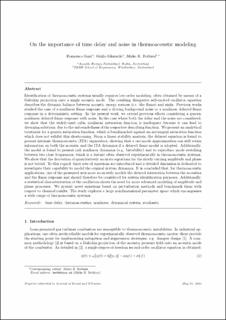Please use this identifier to cite or link to this item:
https://doi.org/10.21256/zhaw-22587Full metadata record
| DC Field | Value | Language |
|---|---|---|
| dc.contributor.author | Gant, Francesco | - |
| dc.contributor.author | Ghirardo, Giulio | - |
| dc.contributor.author | Bothien, Mirko | - |
| dc.date.accessioned | 2021-06-03T14:31:57Z | - |
| dc.date.available | 2021-06-03T14:31:57Z | - |
| dc.date.issued | 2021 | - |
| dc.identifier.issn | 0022-460X | de_CH |
| dc.identifier.uri | https://digitalcollection.zhaw.ch/handle/11475/22587 | - |
| dc.description.abstract | Identification of thermoacoustic systems usually requires low-order modeling, often obtained by means of a Galerkin projection onto a single acoustic mode. The resulting dissipative self-excited oscillator equation describes the dynamic balance between acoustic energy sources (i.e. the flame) and sinks. Previous works studied the case of a nonlinear flame response and a driving background noise or a nonlinear delayed flame response in a deterministic setting. In the present work, we extend previous efforts considering a generic nonlinear delayed flame response with noise. In the case where both the delay and the noise are considered, we show that the widely-used cubic nonlinear saturation function is inadequate because it can lead to diverging solutions, due to the unboundedness of the respective describing function. We present an analytical treatment for a generic saturation function, which is benchmarked against an arctangent saturation function which does not exhibit this shortcoming. From a linear stability analysis, the delayed equation is found to present intrinsic thermoacoustic (ITA) eigenvalues, showing that a one-mode approximation can still retain information on both the acoustic and the ITA dynamics if a delayed flame model is adopted. Additionally, the model is found to present rich nonlinear dynamics (e.g. bistability) and to reproduce mode switching between two close frequencies, which is a feature often observed experimentally in thermoacoustic systems. We show that the derivation of quantitatively accurate equations for the slowly varying ampli- tude and phase is not trivial. To this regard, three sets of equations are introduced and a detailed discussion is dedicated to investigate their capability to model the original system dynamics. It is concluded that, for thermoacoustic applications, one of the presented sets more accurately models the delayed interaction between the acoustics and the flame re- sponse and should therefore be considered for system identification purposes. Additionally, a statistical characterization of the oscillation shows the need for more advanced model- ing of amplitude and phase processes. We present novel equations based on perturbation methods and benchmark them with respect to classical results. The study explores a large nondimensional parameter space which encompasses a wide range of thermoacoustic systems. | de_CH |
| dc.language.iso | en | de_CH |
| dc.publisher | Elsevier | de_CH |
| dc.relation.ispartof | Journal of Sound and Vibration | de_CH |
| dc.rights | Licence according to publishing contract | de_CH |
| dc.subject | Time delay | de_CH |
| dc.subject | Thermoacoustics | de_CH |
| dc.subject | Nonlinear dynamical system | de_CH |
| dc.subject | Stochastic | de_CH |
| dc.subject.ddc | 530: Physik | de_CH |
| dc.title | On the importance of time delay and noise in thermoacoustic modeling | de_CH |
| dc.type | Beitrag in wissenschaftlicher Zeitschrift | de_CH |
| dcterms.type | Text | de_CH |
| zhaw.departement | School of Engineering | de_CH |
| zhaw.organisationalunit | Institut für Energiesysteme und Fluid-Engineering (IEFE) | de_CH |
| dc.identifier.doi | 10.1016/j.jsv.2021.116067 | de_CH |
| dc.identifier.doi | 10.21256/zhaw-22587 | - |
| zhaw.funding.eu | No | de_CH |
| zhaw.issue | 116067 | de_CH |
| zhaw.originated.zhaw | Yes | de_CH |
| zhaw.publication.status | acceptedVersion | de_CH |
| zhaw.volume | 501 | de_CH |
| zhaw.embargo.end | 2023-06-10 | de_CH |
| zhaw.publication.review | Peer review (Publikation) | de_CH |
| zhaw.webfeed | Energiediskurse | de_CH |
| zhaw.webfeed | Erneuerbare Energien | de_CH |
| zhaw.webfeed | Renewable Fuels | de_CH |
| zhaw.author.additional | No | de_CH |
| zhaw.display.portrait | Yes | de_CH |
| Appears in collections: | Publikationen School of Engineering | |
Files in This Item:
| File | Description | Size | Format | |
|---|---|---|---|---|
| 2021_Gant-etal_On-the-importance-of-time-delay-and-noise.pdf | Accepted Version | 2.8 MB | Adobe PDF |  View/Open |
Show simple item record
Gant, F., Ghirardo, G., & Bothien, M. (2021). On the importance of time delay and noise in thermoacoustic modeling. Journal of Sound and Vibration, 501(116067). https://doi.org/10.1016/j.jsv.2021.116067
Gant, F., Ghirardo, G. and Bothien, M. (2021) ‘On the importance of time delay and noise in thermoacoustic modeling’, Journal of Sound and Vibration, 501(116067). Available at: https://doi.org/10.1016/j.jsv.2021.116067.
F. Gant, G. Ghirardo, and M. Bothien, “On the importance of time delay and noise in thermoacoustic modeling,” Journal of Sound and Vibration, vol. 501, no. 116067, 2021, doi: 10.1016/j.jsv.2021.116067.
GANT, Francesco, Giulio GHIRARDO und Mirko BOTHIEN, 2021. On the importance of time delay and noise in thermoacoustic modeling. Journal of Sound and Vibration. 2021. Bd. 501, Nr. 116067. DOI 10.1016/j.jsv.2021.116067
Gant, Francesco, Giulio Ghirardo, and Mirko Bothien. 2021. “On the Importance of Time Delay and Noise in Thermoacoustic Modeling.” Journal of Sound and Vibration 501 (116067). https://doi.org/10.1016/j.jsv.2021.116067.
Gant, Francesco, et al. “On the Importance of Time Delay and Noise in Thermoacoustic Modeling.” Journal of Sound and Vibration, vol. 501, no. 116067, 2021, https://doi.org/10.1016/j.jsv.2021.116067.
Items in DSpace are protected by copyright, with all rights reserved, unless otherwise indicated.